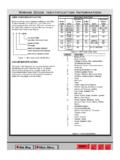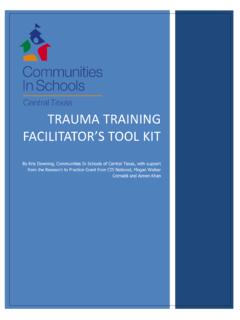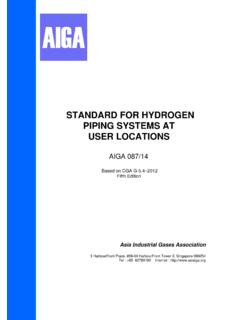Transcription of Information Letter GUIDELINES FOR GROUNDING …
1 Page 1 Revised2/15/97 Information technology Industry Council (ITI, formerly CBEMA) Information LetterGUIDELINES FOR GROUNDING Information technology equipment (ITE)Ninety percent (90%) of the problems withITE installations are internal to the facility;only 10% are related to conditions on theutility electric service. Importantly, 75% ofthe problems arising within a facility arerelated to GROUNDING making proper andadequate GROUNDING the single-mostimportant factor in reliable ITE : To establish GUIDELINES forgrounding of power systems and equipmentfor ITE : Computer room systems, distributedprocessing systems and stand alone : To achieve a low impedance,common ground reference for allinterconnected ITE (InformationTechnology equipment ) to prevent orreduce the likelihood shock hazard; damage fromtransient voltage events; contamination or upsetfrom noise voltage andcurrents in 1 and 2 are typically due to lowfrequency (<100kHz) events.
2 Item 3 istypically due to high frequency (>100kHz) GROUNDING is a legal requirement underOSHA Subchapter S encompassing theNational Electrical Code (NEC) as well asstate and local code Code Requirements. Therequirements stated here are those of 1996 National Electrical Code (NFPA70) most directly applicable to thegrounding of ITE. It is not an exhaustive jurisdictions adopt the NationalElectrical code as a local requirement, butmay have additional requirements as local electrical inspector has the powerto enforce electrical code requirementswithin his or her 250-5 Alternating Current Systems tobe grounded.(b)Ground AC premises wiring systems of50-1000 volts under any of thefollowing conditions:(1)Where the maximum voltage toground on the ungroundedconductors does not exceed 150volts;(2)Where neutral is used as a circuitconductor in a 3-phase, 4-wiresystem;(3)Where the midpoint of one phase isused as a circuit conductor in a 3-phase, 4-wire delta connectedsystem;(4)Where the grounded serviceconductor is uninsulated inaccordance with the Exceptions toSections 230-22, 230-30, and 230-41.
3 (d)Separately Derived Systems. Apremises wiring system whose power isderived from generator, transformer, orconverter windings and has no directelectrical connection, including asolidly connected grounded circuitconductor (neutral), to supplyconductors originating in anothersystem, if required to be grounded in (b)above, shall be grounded as specified inSection 250-21 Objectionable Current overGrounding Conductors.(b)If the use of multiple groundingconnections results in an objectionablePage 2 Revised2/15/97flow of current, one or more of thefollowing alterations shall be made.(1)Discontinue one or more, but notall such connections;(2)Change the locations of thegrounding connections;(3)Interrupt the continuity of theconductor or conductive pathinterconnecting the groundingconnections;(4)Take other suitable remedial actionas permitted by the localjurisdiction.
4 (d)Limitations to Permissible provisions of this section shall notbe considered as permitting electronicequipment being operated on acsystems or branch circuits that are notgrounded as required by this that introduce noise or dataerrors in electronic equipment shall notbe considered as the objectionablecurrents addressed in this 250-23(a)System GROUNDING Connections..Thegrounding electrode conductor shall beconnected to the grounded conductor(neutral) at any accessible point fromthe load end of the service andincluding the terminal or bus to whichthe grounded service conductor isconnected at the service Agrounding connection shall not be madeto any grounded circuit conductor(neutral) on the load side of the a separately derived system, ( transformer) a groundingelectrode conductor shall be connected tothe grounded conductor (neutral) inaccordance with NEC 250-26 A separately derived systemrequired to be grounded by NEC 250-5 shallbe grounded as follows:(a)A bonding jumper of appropriate sizeshall connect the equipment groundingconductor (green wire) of the derivedsystem to the derived system groundedconductor (neutral).
5 This connectionshall be made at any point on theseparately derived system from thesource to the first system disconnectionmeans or overcurrent GROUNDING electrode conductor ofappropriate size shall be used to connectthe grounded conductor (neutral) to thegrounding electrode..This connectionshall be made at any point on theseparately derived system from thesource to the first system disconnectingmeans or overcurrent (c)The GROUNDING electrode shall be asnear as practicable to the system to begrounded and shall be:(1)the nearest effectively groundedstructural metal member of thestructure;(2)the nearest effectively groundedmetal water pipe;(3)other electrodes specified in 250-81or 250-83 where (1) and (2) aboveare not 250-51 Effective GROUNDING Path. Thepath to ground from circuits, equipment andmetal enclosures shall (1) be permanent andcontinuous; (2) have capacity to conductsafely any fault current likely to be imposedon it; and (3) have sufficiently lowimpedance to limit the voltage to ground andto facilitate the operation of the circuitprotection earth shall not be used as the soleequipment GROUNDING 250-53 GROUNDING Path to GroundingElectrode at Services(a) GROUNDING Electrode Conductor.
6 Agrounding electrode conductor shall beused to connect the equipmentgrounding conductors, the serviceequipment conductors, and where thesystem is grounded, the groundedservice conductor to the groundingelectrode.(b)Main Bonding Jumper. For a groundedsystem. an unspliced main bondingjumper shall be used to connect thePage 3 Revised2/15/97equipment GROUNDING conductor and theservice-disconnect enclosure to thegrounded conductor of the system ateach service 250-54 Common GroundingElectrode. Where an ac system is connectedto a GROUNDING electrode in or at abuilding,..the same electrode shall be usedto ground conductor enclosures andequipment in or at that building. Whereseparate services supply a building and arerequired to be connected to a groundingelectrode, the same GROUNDING electrodeshall be or more GROUNDING electrodes that areeffectively bonded together shall beconsidered as a single GROUNDING electrodesystem in this 250-74 Connecting ReceptacleGrounding Terminal to 4:Where required forthe reduction of electrical noise(electromagnetic interference) on thegrounding circuit, a receptacle in whichthe GROUNDING terminal is purposelyinsulated from the receptacle groundingterminal shall be grounded by aninsulated equipment groundingconductor run with the circuitconductors.
7 This GROUNDING conductorshall be permitted to pass through oneor more panelboards without connectionto the panelboard GROUNDING terminal aspermitted in Section 384-20 Exceptionso as to terminate directly at anequipment GROUNDING conductorterminal of the applicable system : Use of an isolated equipmentgrounding conductor does not relievethe requirement for GROUNDING theraceway system and outlet 250-75 Bonding Other : Where required for thereduction of electrical noise(electromagnetic interference) on thegrounding circuit, an equipmentenclosure supplied by a branch circuitshall be permitted to be isolated from araceway containing circuits supplyingonly that equipment by one or morelisted nonmetallic raceway fittingslocated at the point of attachment of theraceway to the equipment metal raceway shall comply withthe provisions of this article and shallbe supplemented by an internalinsulated equipment groundingconductor installed in accordance withSection 250-74, Exception 4 to groundthe equipment .
8 Use of an isolated equipmentgrounding conductor does not relievethe requirement for GROUNDING theraceway 250-81 GROUNDING Electrode available on the premises at each buildingserved, each of a-d below and any madeelectrodes in accordance with NEC 250-83must be bonded together to form agrounding electrode (a)Metal underground water pipe locatedless than 5 ft. from its entrance to thebuilding (when augmented by at leastone of b-d below or made electrodes perNEC 250-83);(b)Metal frame of the building (whereeffectively grounded);(c)Concrete encased electrode (generallyformed by the rebar in the buildingfoundation);(d)Ground 250-83 Made and Other none of the above are available, oneor more of the electrodes in b-d below shallbe used.(a)A metal underground gas piping systemshall not be used as a groundingelectrode;(b)Other local underground systems andstructures;(c)Rod or pipe electrodes;(d)Plate 4 Revised2/15/97 NEC 250-91(b)The equipment GROUNDING conductorrun with or enclosing the circuitconductors shall be one or more.
9 Ofthe following: (1) copper or othercorrosion resistant conductor ..insulated, covered or bare; solid orstranded or busbar; (2) rigid metalconduit, (3) intermediate metal conduit,(4) electrical metallic tubing, (5)flexible metal conduit and fittingswhere listed for such service, (6) armorof Type AC cable, (7) copper sheath ofmineral insulated metal shielded cable,(8) metallic sheath and/or groundingconductors of Type MC cable, (9) cabletrays as permitted in Sections 318-3(c)and 318-7, (10) cablebus framework aspermitted in Section 365-2(a)..(c)Supplementary GROUNDING electrodesshall be permitted to augmentequipment GROUNDING conductors(provided all of the NEC groundingconductors are installed per applicablesections of Article 250), but earth shallnot be used as the sole other words, extra driven ground rod orrods may be used to augment the groundingsystem, but if used, must be connected usingan acceptable GROUNDING electrode conductorto other GROUNDING electrodes listed isolated earth ground is prohibited by 384-20.
10 In panelboards, equipmentgrounding conductors shall not be connectedto a terminal bar provided for groundedconductors (neutrals) unless the bar isidentified for the purpose and is locatedwhere connection is made from thegrounded conductor to a groundingelectrode conductor as permitted by 645-15 Electronic computer/dataprocessing equipment (in an electroniccomputer/data processing room) shall begrounded in accordance with Article 250 ordouble insulated. Power systems derivedwithin listed electronic computer/dataprocessing equipment that supply electroniccomputer/data processing systems throughreceptacles or cable assemblies supplied aspart of this equipment shall not beconsidered separately derived for thepurpose of applying Section 250-5(d). Allexposed, noncurrent carrying metal parts ofan electronic computer/data processingsystem shall be POWER SYSTEMSP ower systems with the neutral conductorsolidly bonded to the GROUNDING electrodeconductor at an on-premises point in thedistribution system, may not always be thecase particularly at locations outside NorthAmerica.



